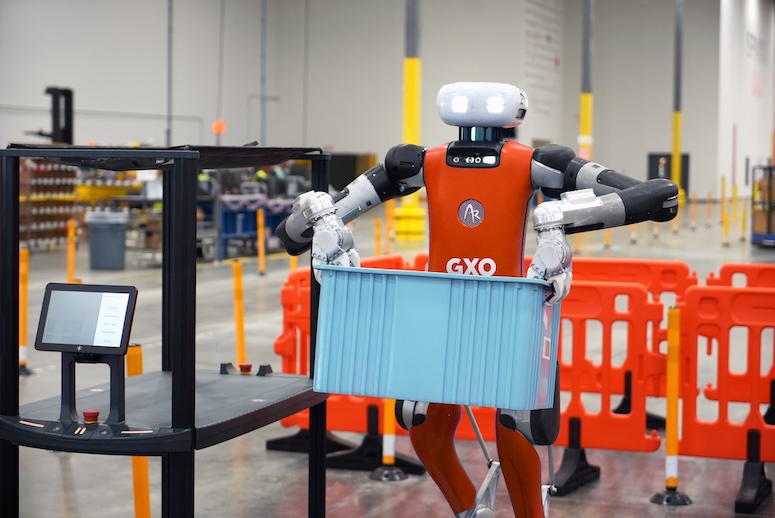|
Listen to this article |
There are lots of questions about humanoid robots as they start to make their way into commercial markets. While the “wheels versus legs” debate is the go-to topic, questions about the business model — cost, ROI, etc. — are also top of mind. Agility Robotics CEO Peggy Johnson gave us a quick peek behind the curtain for Digit while speaking at a tech conference this week.
Agility Robotics recently landed the first paying customer for its Digit humanoid, which won The Robot Report‘s inaugural RBR50 Robot of the Year Award earlier in 2024.
A “small fleet” of Digit humanoids is currently deployed at a Spanx facility in Flowery Branch, Georgia. Digit picks up totes from 6 River Systems‘ Chuck autonomous mobile robots (AMRs) and places the totes onto conveyors. Digit can pick up empty or totes full of the women’s shapewear product. It can also pick up totes from either the bottom or top shelf of an AMR.
All of this work is orchestrated through Agility Arc, the company’s cloud automation platform for deploying and managing Digit fleets. The robots are deployed under a robots-as-a-service model (RaaS), meaning Agility Robotics started earning a small amount of revenue for Digit. This was a major milestone for a humanoid company.
Many folks within the robotics industry were left wanting more information, however, particularly around the cost. And that’s where Johnson’s comments help shed some light. She said Agility Robotics is currently charging a “fully loaded $30 per hour” for its Digit humanoid. She said the return on investment (ROI) for customers is under two years.
That cost-per-hour figure for the humanoid, all accessories, and maintenance seems reasonable. Now, it’s unlikely that Digit is working 24 hours a day, 365 days a year, but let’s pretend it is for argument’s sake. The math comes out to $125,000 over two years per robot. Those figures would be different with a normal eight-hour shift, of course.

GXO signed a multi-year deal with Agility Robotics to deploy its Digit humanoid in warehouses. | Credit: Agility Robotics
Next generation of Digit coming soon
Agility Robotics said the battery life for Digit is currently up to eight hours, depending on usage. This is another important point Johnson discussed on stage. She explained that the company is at a 2-to-1 ratio for Digit, meaning customers get two units of operating time while another unit is charging.
Johnson added that the next generation of Digit will be released this fall. Its lifting capacity will increase from 35 to 50 lb. (15.8 to 22.6 kg), battery life will be improved, and more units of Digit will be available, she said. That 2-to-1 ratio will be gradually increased to 4-to-1 and potentially 10-to-1 to improve a customer’s ROI.
As the cost of components such as batteries declines and hardware deployments scale, that ROI should be faster and easier to obtain.
Amazon has also tested Digit and invested in Agility Robotics. However, the details of that relationship and of Amazon’s tests of Digit were unclear at press time.
Humanoids don’t collaborate with humans — yet
Johnson, who was named CEO of Agility Robotics in March 2024, also talked briefly about working near humans. There are no safety standards for humanoids, although there are various efforts under way to rectify that.
At the Spanx facility, Digit isn’t currently working near humans. The robot is 5 ft., 9 in. (5.7 m) tall and weighs 140 lb. (63.5 kg).
But Johnson said Digit is “on a path to what’s called functional safety” and that it could “interoperate near humans” in the next 18 months or so. If that pans out, it would be yet another important milestone for humanoids, of which there are a growing number these days.
Boston Dynamics, Figure, Fourier Intelligence, Persona AI, Sanctuary, Tesla, and Unitree are just a few of the other companies also working on commercial humanoids.
Agility Robotics continues fundraising
Finally, Johnson also said Agility Robotics is currently raising its Series C round. She said that will “take us out the next couple of years until we hit that 10,000 unit [mark].” The company anticipates the production capacity for Digit will be more than 10,000 per year at its new RoboFab factory in Oregon.
Agility Robotics last raised a $150 million Series B round in early 2022. More recently, Figure raised $675 million to develop its own humanoids, which are behind Digit at this point. While that could certainly change, it’ll be interesting to see how much a humanoid company with actual robots in the field can raise from investors.
“Right now, humanoid robots are having a moment, for sure,” said Johnson.

